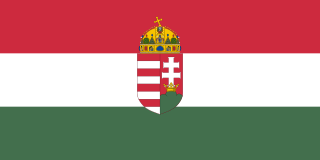Related Research Articles

The Kingdom of Yugoslavia was a state in Southeast and Central Europe that existed from 1918 until 1941. From 1918 to 1929, it was officially called the Kingdom of Serbs, Croats and Slovenes, but the term "Yugoslavia" was its colloquial name due to its origins. The official name of the state was changed to "Kingdom of Yugoslavia" by King Alexander I on 3 October 1929.
An appellation is a legally defined and protected geographical indication primarily used to identify where the grapes for a wine were grown, although other types of food often have appellations as well. Restrictions other than geographical boundaries, such as what grapes may be grown, maximum grape yields, alcohol level, and other quality factors may also apply before an appellation name may legally appear on a wine bottle label. The rules that govern appellations are dependent on the country in which the wine was produced.

Cisleithania was a common yet unofficial name for the northern and western part of Austria-Hungary, the Dual Monarchy created in the Compromise of 1867—as distinguished from Transleithania.

King of Italy was the title given to the ruler of the Kingdom of Italy after the fall of the Western Roman Empire. The first to take the title was Odoacer, a barbarian military leader, in the late 5th century, followed by the Ostrogothic kings up to the mid-6th century. With the Frankish conquest of Italy in the 8th century, the Carolingians assumed the title, which was maintained by subsequent Holy Roman Emperors throughout the Middle Ages. The last Emperor to claim the title was Charles V in the 16th century. During this period, the holders of the title were crowned with the Iron Crown of Lombardy.

In Libya there are currently 106 districts, second level administrative subdivisions known in Arabic as baladiyat. The number has varied since 2013 between 99 and 108. The first level administrative divisions in Libya are currently the governorates (muhafazat), which have yet to be formally deliniated, but which were originally tripartite as: Tripolitania in the northwest, Cyrenaica in the east, and Fezzan in the southwest; and later divided into ten governorates.

The Illyrian Provinces were an autonomous province of France during the First French Empire that existed under Napoleonic Rule from 1809 to 1814. The province encompassed modern-day Slovenia, Gorizia, Trieste, and parts of Croatia and Austria. Its capital was Ljubljana in Slovenia. It encompassed six départements, making it a relatively large portion of territorial France at the time. Parts of Croatia were split up into Civil Croatia and Military Croatia, the former served as a residential space for French immigrants and Croatian inhabitants and the latter as a military base to check the Ottoman Empire.

The Kingdom of Sicily was a state that existed in the south of the Italian peninsula and for a time the region of Ifriqiya from its founding by Roger II of Sicily in 1130 until 1816. It was a successor state of the County of Sicily, which had been founded in 1071 during the Norman conquest of the southern peninsula. The island was divided into three regions: Val di Mazara, Val Demone and Val di Noto; val being the apocopic form of the word vallo, derived from the Arabic word wilāya.

The Duchy of Parma also referred to as Duchy of Parma and Piacenza, was an Italian state created in 1545 and located in northern Italy, in the current region of Emilia-Romagna.

Southern Italy, also known as Meridione or Mezzogiorno, is a macroregion of Italy consisting of the southern half of the Italian state.

The lira was the currency of Italy between 1861 and 2002. It was first introduced by the Napoleonic Kingdom of Italy in 1807 at par with the French franc, and was subsequently rolled out by the different states that would eventually form the Kingdom of Italy in 1861. It was subdivided into 100 centesimi, which means "hundredths" or "cents". The lira was also the currency of the Albanian Kingdom from 1941-1943.

The Italian Parliament is the national parliament of the Italian Republic. It is the representative body of Italian citizens and is the successor to the Parliament of the Kingdom of Italy (1861–1943), the transitional National Council (1943–1945) and the Constituent Assembly (1946–1948). It is a bicameral legislature with 945 elected members and a small number of unelected members. The Italian Parliament is composed of the Chamber of Deputies and Senate of the Republic. The two Houses are independent from one another and never meet jointly except under circumstances specified by the Constitution. Following a referendum on 21 September 2020, the number of MPs in the Parliament will be reduced from 630 to 400 in the Chamber of Deputies and from 315 to 200 in the Senate starting with the next legislature.

The Italian Republic was a short-lived (1802–1805) republic located in Northern Italy. Napoleon Bonaparte served as president and its capital was Milan.

The Kingdom of Italy was a kingdom in Northern Italy in personal union with France under Napoleon I. It was fully influenced by revolutionary France and ended with Napoleon's defeat and fall. Its government was assumed by Napoleon as King of Italy and the viceroyalty delegated to his step-son Eugène de Beauharnais. It covered Savoy and the modern provinces of Lombardy, Veneto, Emilia-Romagna, Friuli Venezia Giulia, Trentino, South Tyrol, and Marche. Napoleon I also ruled the rest of northern and central Italy in the form of Nice, Aosta, Piedmont, Liguria, Tuscany, Umbria, and Lazio, but directly as part of the French Empire, rather than as part of a vassal state.

The Kingdom of Dalmatia was a crown land of the Austrian Empire (1815–1867) and the Cisleithanian half of Austria-Hungary (1867–1918). It encompassed the entirety of the region of Dalmatia, with its capital at Zadar.

The nobility of Italy comprised individuals and their families of the Italian Peninsula, and the islands linked with it, recognized by the sovereigns of the Italian city-states since the Middle Ages, and by the kings of Italy after the unification of the region into a single state, the Kingdom of Italy.

The Subalpine Republic was a short-lived republic that existed between 1800 and 1802 on the territory of Piedmont during its military rule by Napoleonic France.

Members of the European Parliament (MEPs) are elected by the population of the member states of the European Union (EU). The European Electoral Act 2002 allows member states the choice to allocate electoral subdivisions or constituencies for the European Parliament elections in several different ways.

The "Manifesto of Race", sometimes known as the Charter of Race or Racial Manifesto, was a manifesto published on the 14th of July 1938 which prepared the enactment, in October 1938, of the Racial Laws in the Kingdom of Italy. The antisemitic laws stripped the Jews of Italian citizenship and governmental and professional positions. The manifesto demonstrated the enormous influence Adolf Hitler had over Benito Mussolini since Italy had become allied with Nazi Germany.

Italy–United Kingdom relations, also known as Anglo–Italian relations or Italo–British relations, are the international relations between the Italian Republic and the United Kingdom of Great Britain and Northern Ireland. Bilateral relationships between Italy and the United Kingdom are warm and exceptionally strong.

The Kingdom of Hungary, sometimes referred to as the Regency or the Horthy era, existed as a country from 1920 to 1946 under the rule of Regent Miklós Horthy. Horthy nominally represented the Hungarian monarchy. In reality there was no king. Attempts by Charles IV to return to the throne were prevented by Horthy.